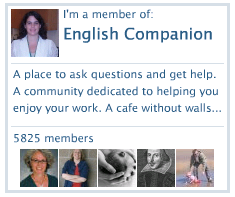Today’s post is part of the Simple K12 Blog Swap. I met James Gubbins at FETC earlier this year and am excited to participate in this with him as a partner. I can personally vouch for the message he speaks of here about building strong networks to improve your teaching. Enjoy the post!
What an honor to be included in the I Heart EdTech Blog Swap brought to you by SimpleK12.com.. When I found out the regular author of Teacher in Transition was my partner for this project, I started thinking about the title of her blog and how I could compose a post that could fit the theme.
Any educator interested in integrating technology into the curriculum, has likely heard about the importance of a PLN (Personal Learning Network). You’ve likely encountered words and phrases that may seem a bit foreign: Nings, Wikis, Blogs, Twitter, Plurk, Shoutem, Pearltree, Delicious, Middlespot, LinkedIn, YouTube, Facebook (The last 2 have become part of the social norm – but are often just as taboo inside the walls of a school.) What could these intriguing phrases possibly have in common? They are all ways to expand the four walls of your classroom or school building and reach educators with similar interests from all around the world.
The keen observer may note four different groupings listed above. Before discussing the importance of a PLN, it helps to lay the groundwork by defining these categories.
Collaborative Webspaces: Nings, Wiki’s and Blogs are content management resources that allow you to share information with peers locally and around the world very easily.
Microblogging: I often hear, “I don’t have time to dedicate to an online community.” I think that’s rubbish. The explosion of 140 character status updates, makes it practically a crime not to take advantage of tools like Twitter, Plurk and Shoutem that make Microblogging possible.
Social Bookmarking: Social Bookmarking not only allows you to store this information on the internet, but allows your network to share these links as well. Sites like Delicious, Middlespot, and Pearltrees allow you to create large communities of people with like interests and keeping you from having to re-invent the wheel.
Social Networking: Social networking is strictly forboden in many school districts. However, these sites were among the first to make us feel connected as a global society. Sites like Linkedin, Youtube and Facebook all have some extremely redeeming qualities once you sort through the fodder.
Now that you have a sense of the categories, you can start building a Personal Learning Network (PLN) that will soon become one of your most cherished and meaningful resources. As you start to delve into these sites, you have a responsibility to be a trusted digital citizen by producing valuable content and reflecting on the works of others. Building a learning network is more than having an outreach, it’s about lending a helping hand. There is much give and take when cultivating these internet relationships.
As you start to read the posts and view the works of others on the various sites, you begin to gain an understanding of different user’s philosophies and quickly realize who you can turn too when you are in a pinch. There are real people in Cyberspace.
One of my favorite events at educational technology conferences is finding the “TweetUps”. These events allow you to meet the face behind your favorite Twitter avatar. These are the most memorable events of a conference week for me because they facilitate fantastic conversations. They help reveal the true person behind the 140 characters.
When you visit a site in the categories mentioned above for the first time you will feel overwhelmed. Fear not, this is normal! There is a plethora of information available. The best thing to do is find the sites search tool, start looking for words meaningful to you and find like minded individuals. I would search for, “professional development” “edtech” “technical” “social” “presenter” because these closely relate to my work. Start by “lurking” on the sites and following people who interest you. Eventually, you will become part of the pulse of that resource.
Adding more confusion to the mix, I believe you should maintain two learning networks! It’s a little more work, but worth it in the long run. One should be your Global Learning Network (GLN). Your GLN should contain accounts that follow as many people in your field as possible. Put your ego aside and don’t concern yourself with how many people follow you back. You’ll have a constant stream of information available at your fingertips and increase the likelihood of getting a response when you shout into cyberspace. Your Personal Learning Network (PLN) should actually be small by comparison. This is where you actively become involved with your peers and colleagues closest to you. The conversations may not always be riveting, but they will always be valuable. Your PLN should be your comfort zone. As you add content to these sites, the people who find your information valuable will begin to follow you. Your PLN will likely become unbalanced in the other direction. You will end up with more followers than those you follow. Finding the proper balance for both networks is key.
Finally, a lot of people like to keep their accounts at these sites private. By locking these sites down to keep people outside of your “clique” from seeing your updates you not only cheat yourself, but the world! Don’t be afraid to share your insight!
Incidentally, if you want to add me to any of your learning networks, I can typically be found by searching JGubbins207 or on Twitter as JMGubbins. I look forward to meeting you in the cloud! Happy surfing!










